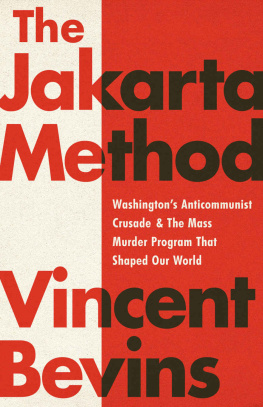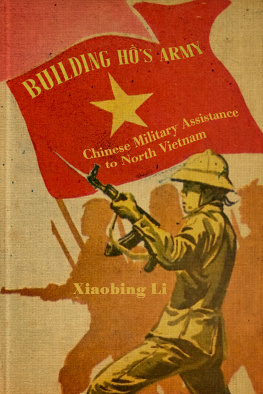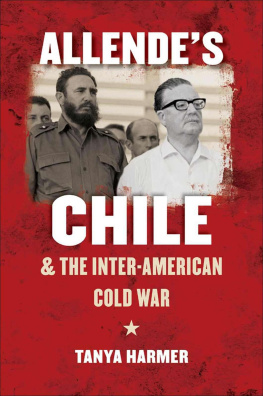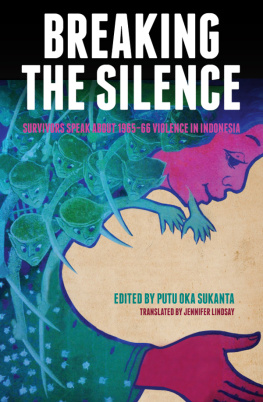Copyright 2020 by Vincent Bevins
Cover design by Pete Garceau
Cover copyright 2020 Hachette Book Group, Inc.
Hachette Book Group supports the right to free expression and the value of copyright. The purpose of copyright is to encourage writers and artists to produce the creative works that enrich our culture.
The scanning, uploading, and distribution of this book without permission is a theft of the authors intellectual property. If you would like permission to use material from the book (other than for review purposes), please contact permissions@hbgusa.com. Thank you for your support of the authors rights.
PublicAffairs
Hachette Book Group
1290 Avenue of the Americas, New York, NY 10104
www.publicaffairsbooks.com
@Public_Affairs
Published by PublicAffairs, an imprint of Perseus Books, LLC, a subsidiary of Hachette Book Group, Inc. The PublicAffairs name and logo is a trademark of the Hachette Book Group.
The Hachette Speakers Bureau provides a wide range of authors for speaking events. To find out more, go to www.hachettespeakersbureau.com or call (866) 376-6591.
The publisher is not responsible for websites (or their content) that are not owned by the publisher.
Library of Congress Cataloging-in-Publication Data
Names: Bevins, Vincent, author.
Title: The Jakarta method: Washingtons anticommunist crusade and the mass murder program that shaped our world / Vincent Bevins.
Other titles: Washingtons anticommunist crusade and the mass murder program that shaped our world
Description: New York: PublicAffairs, [2020] | Includes bibliographical references.
Identifiers: LCCN 2019046069 | ISBN 9781541742406 (hardcover) | ISBN 9781541724013 (ebook)
Subjects: LCSH: United StatesForeign relations19451989. | Developing countriesForeign relationsUnited States. | United StatesForeign relationsDeveloping countries. | Anti-communist movementsDeveloping countriesHistory20th century. | Autonomy and independence movementsHistory20th century. | Political violenceDeveloping countriesHistory20th century. | IndonesiaHistoryCoup dtat, 1965. | Cold War. | United States. Central Intelligence AgencyHistory20th century.
Classification: LCC E744 .B476 2020 | DDC 327.73009/04dc23
LC record available at https://lccn.loc.gov/2019046069
ISBNs: 978-1-5417-4240-6 (hardcover), 978-1-5417-2401-3 (ebook)
E3-20200415-JV-NF-ORI
For Bu Cisca and Pak Hong Lan Oei
I N M AY 1962, A YOUNG girl named Ing Giok Tan got on a rusty old boat in Jakarta, Indonesia. Her country, one of the largest in the world, had been pulled into the global battle between capitalism and communism, and her parents decided to flee the terrible consequences that conflict had wrought for families like hers. They set sail for Brazil, having heard from other Indonesians who had already made the journey that this place offered freedom, opportunity, and respite from conflict. But they knew almost nothing about it. Brazil was just an idea for them, and it was very far away. Suffering through anxiety and seasickness for forty-five days, they made their way past Singapore, across the Indian Ocean to Mauritius, down past Mozambique, around South Africa, and then all the way across the Atlantic to So Paulo, the largest city in South America.
If they thought they could escape the violence of the Cold War, they were tragically mistaken. Two years after they arrived, the military overthrew Brazils young democracy and established a violent dictatorship. After that, the new Indonesian immigrants in Brazil received messages from home describing the most shocking scenes imaginable, an explosion of violence so terrifying that even discussing what happened would make people break down, questioning their own sanity. But the reports were all true. In the wake of that apocalyptic slaughter in Indonesia, a young nation littered with mutilated bodies emerged as one of Washingtons most reliable allies, and then largely disappeared from history.
What happened in Brazil in 1964 and Indonesia in 1965 may have been the most important victories of the Cold War for the side that ultimately wonthat is, the United States and the global economic system now in operation. As such, they are among the most important events in a process that has fundamentally shaped life for almost everyone. Both countries had been independent, standing somewhere in between the worlds capitalist and communist superpowers, but fell decisively into the US camp in the middle of the 1960s.
Officials in Washington and journalists in New York certainly understood how significant these events were at the time. They knew that Indonesia, now the worlds fourth most-populous country, was a far more important prize than Vietnam ever could have been. In just a few months, the US foreign policy establishment achieved there what it failed to get done in ten bloody years of war in Indochina.
And the dictatorship in Brazil, currently the worlds fifth most-populous country, played a crucial role in pushing the rest of South America into the pro-Washington, anticommunist group of nations. In both countries, the Soviet Union was barely involved.
Most shockingly, and most importantly for this book, the two events led to the creation of a monstrous international network of exterminationthat is, the systematic mass murder of civiliansacross many more countries, which played a fundamental role in building the world we all live in today.
Unless you are Indonesian, or a specialist on the topic, most people know very little about Indonesia, and almost nothing about what happened in 196566 in that archipelago nation. Indonesia remains a huge gap in our collective general knowledge, even among people who do know a little about the Cuban Missile Crisis, or the Korean War, or Pol Pot, or can easily rattle off some basic facts about the worlds most-populous country (China), the second most-populous (India), or even numbers six and seven (Pakistan and Nigeria). Even among international journalists, few people know that Indonesia is the worlds largest Muslim-majority country, let alone that in 1965, it was home to the worlds largest Communist Party outside the Soviet Union and China.
The truth of the violence of 196566 remained hidden for decades. The dictatorship established in its wake told the world a lie, and survivors were imprisoned or too terrified to speak out. It is only as a result of the efforts of heroic Indonesian activists and dedicated scholars around the world that we can now tell the story. Documents recently declassified in Washington have been a huge help, though some of what happened still remains shrouded in mystery.
Indonesia likely fell off the proverbial map because the events of 19651966 were such a complete success for Washington. No US soldiers died, and no one at home was ever in danger. Although Indonesian leaders in the 1950s and 1960s had played a huge international role, after 1966 the country stopped rocking the boat entirely. I know from thirteen years of working as a foreign correspondent and journalist that faraway countries that are stable and reliably pro-American do not make headlines. And personally, after going through the documentation and spending a lot of time with the people who lived through these events, I came to form another, deeply unsettling theory as to why these episodes have been forgotten. I fear that the truth of what happened contradicts so forcefully our idea of what the Cold War was, of what it means to be an American, or how globalization has taken place, that it has simply been easier to ignore it.
This book is for those who have no special knowledge of Indonesia, or Brazil, or Chile or Guatemala or the Cold War, though I hope that my interviews, archival research, and global approach may have delivered some discoveries that may be interesting for the experts too. Most of all I hope this story can get to people who want to know how violence and the war against communism intimately shaped our lives todaywhether you are sitting in Rio de Janeiro, Bali, New York, or Lagos.










